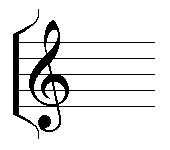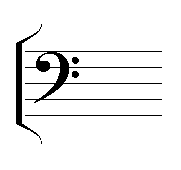

| 1. The treble clef is an old-fashioned
letter "G", and it curls round the second line of the stave,
indicating that a note on this line has the note name "G".
This is the "G" above middle "C", in the centre of the woman's
singing voice.
|

| 2. The bass clef is an old-fashioned
letter "F", and it has the two dots either side of the fourth line,
indicating that a note on this line has the note name "F", the "F"
below middle "C", in the centre of a man's singing voice.
|

| 3. The C clef is simply a brace which straddles the line which is middle "C".
It is often called the alto clef and is nowadays only used by specific alto instruments such as the Viola.
|

| 4. The C clef is occasionally seen in different positions.
This simply indicates that middle "C" is the line the brace centres on.
This example is often called the tenor clef and is sometimes used by a 'Cello when playing
in the upper part of its register.
|

| 5. Confusingly, this one is also called a tenor clef, but is only used for tenor voices. It is the same as the treble clef, but is read an octave down. The little "8" at the bottom of the tail is in fact often omitted, so that it looks exactly like a treble clef, but tenors knows that they should sing an octave down. |
Frequently Asked Question: Why do we bother with different clefs - they are just confusing!
Answer: It's because different voices and different instruments have different ranges, in other words, they can play different pitches of notes. The notes for a flute part could not be written on a stave with the same clef and the notes for a double bass.